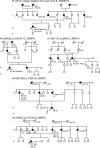Mutation status of RAD51C, PALB2 and BRIP1 in 100 Japanese familial breast cancer cases without BRCA1 and BRCA2 mutations
- PMID: 28796317
- PMCID: PMC5666035
- DOI: 10.1111/cas.13350
Mutation status of RAD51C, PALB2 and BRIP1 in 100 Japanese familial breast cancer cases without BRCA1 and BRCA2 mutations
Abstract
In addition to BRCA1 and BRCA2, RAD51C, PALB2 and BRIP1 are known as breast cancer susceptibility genes. However, the mutation status of these genes in Japanese familial breast cancer cases has not yet been evaluated. To this end, we analyzed the exon sequence and genomic rearrangement of RAD51C, PALB2 and BRIP1 in 100 Japanese patients diagnosed with familial breast and ovarian cancer and without BRCA1 and BRCA2 mutations. We detected a large deletion from exons 6 to 9 in RAD51C, 4 novel BRIP1 missense variants containing 3 novel non-synonymous variants, c.89A>C, c.736A>G and c.2131A>G, and a splice donor site variant c.918+2T>C. No deleterious variant of PALB2 was detected. The results of pedigree analysis showed that the proband with a large deletion on RAD51C had a family history of both breast and ovarian cancer, and the families of probands with novel BRIP1 missense variants included a male patient with breast cancer or many patients with breast cancer within the second-degree relatives. We showed that the mutation frequency of RAD51C in Japanese familial breast cancer cases was similar to that in Western countries and that the prevalence of deleterious mutation of PALB2 was possibly lower. Furthermore, our results suggested that BRIP1 mutation frequency in Japan might differ from that in Western countries.
Keywords: BRIP1; PALB2; RAD51C; Japanese; hereditary breast cancer.
© 2017 The Authors. Cancer Science published by John Wiley & Sons Australia, Ltd on behalf of Japanese Cancer Association.
Figures

Similar articles
-
Cost-effectiveness of Population-Based BRCA1, BRCA2, RAD51C, RAD51D, BRIP1, PALB2 Mutation Testing in Unselected General Population Women.J Natl Cancer Inst. 2018 Jul 1;110(7):714-725. doi: 10.1093/jnci/djx265. J Natl Cancer Inst. 2018. PMID: 29361001
-
Screening for BRCA1, BRCA2, CHEK2, PALB2, BRIP1, RAD50, and CDH1 mutations in high-risk Finnish BRCA1/2-founder mutation-negative breast and/or ovarian cancer individuals.Breast Cancer Res. 2011 Feb 28;13(1):R20. doi: 10.1186/bcr2832. Breast Cancer Res. 2011. PMID: 21356067 Free PMC article.
-
Germline pathogenic variants in BRCA1, BRCA2, PALB2 and RAD51C in breast cancer women from Argentina.Breast Cancer Res Treat. 2019 Dec;178(3):629-636. doi: 10.1007/s10549-019-05411-9. Epub 2019 Aug 24. Breast Cancer Res Treat. 2019. PMID: 31446535
-
Frequency of heterozygous germline pathogenic variants in genes for Fanconi anemia in patients with non-BRCA1/BRCA2 breast cancer: a meta-analysis.Breast Cancer Res Treat. 2020 Jul;182(2):465-476. doi: 10.1007/s10549-020-05710-6. Epub 2020 Jun 2. Breast Cancer Res Treat. 2020. PMID: 32488392
-
What About the Others? Clinical Management of Gynecologic Cancer Risk in Patients With Moderate-Risk Hereditary Cancer Genes ( ATM , BRIP1 , RAD51C , RAD51D , and PALB2 ).Clin Obstet Gynecol. 2024 Dec 1;67(4):696-701. doi: 10.1097/GRF.0000000000000897. Epub 2024 Sep 26. Clin Obstet Gynecol. 2024. PMID: 39324947 Review.
Cited by
-
Breast Cancer Predisposition Genes and Synthetic Lethality.Int J Mol Sci. 2021 May 25;22(11):5614. doi: 10.3390/ijms22115614. Int J Mol Sci. 2021. PMID: 34070674 Free PMC article. Review.
-
Biomarkers in Breast Cancer: An Old Story with a New End.Genes (Basel). 2023 Jun 28;14(7):1364. doi: 10.3390/genes14071364. Genes (Basel). 2023. PMID: 37510269 Free PMC article. Review.
-
BRIP1, RAD51C, and RAD51D mutations are associated with high susceptibility to ovarian cancer: mutation prevalence and precise risk estimates based on a pooled analysis of ~30,000 cases.J Ovarian Res. 2020 May 2;13(1):50. doi: 10.1186/s13048-020-00654-3. J Ovarian Res. 2020. PMID: 32359370 Free PMC article.
-
Treatment of ovarian cancer: From the past to the new era (Review).Oncol Lett. 2025 Jun 3;30(2):384. doi: 10.3892/ol.2025.15130. eCollection 2025 Aug. Oncol Lett. 2025. PMID: 40535104 Free PMC article. Review.
-
Alterations in the expression of homologous recombination repair (HRR) genes in breast cancer tissues considering germline BRCA1/2 mutation status.Breast Cancer Res Treat. 2024 Dec;208(3):501-510. doi: 10.1007/s10549-024-07441-4. Epub 2024 Jul 30. Breast Cancer Res Treat. 2024. PMID: 39080120 Free PMC article.
References
-
- Daly MB, Pilarski R, Berry M et al NCCN guidelines insights: genetic/familial high‐risk assessment: breast and ovarian, Version 2.2017. J Natl Compr Canc Netw 2017; 15: 9–20. - PubMed
MeSH terms
Substances
LinkOut - more resources
Full Text Sources
Other Literature Sources
Medical
Research Materials
Miscellaneous

